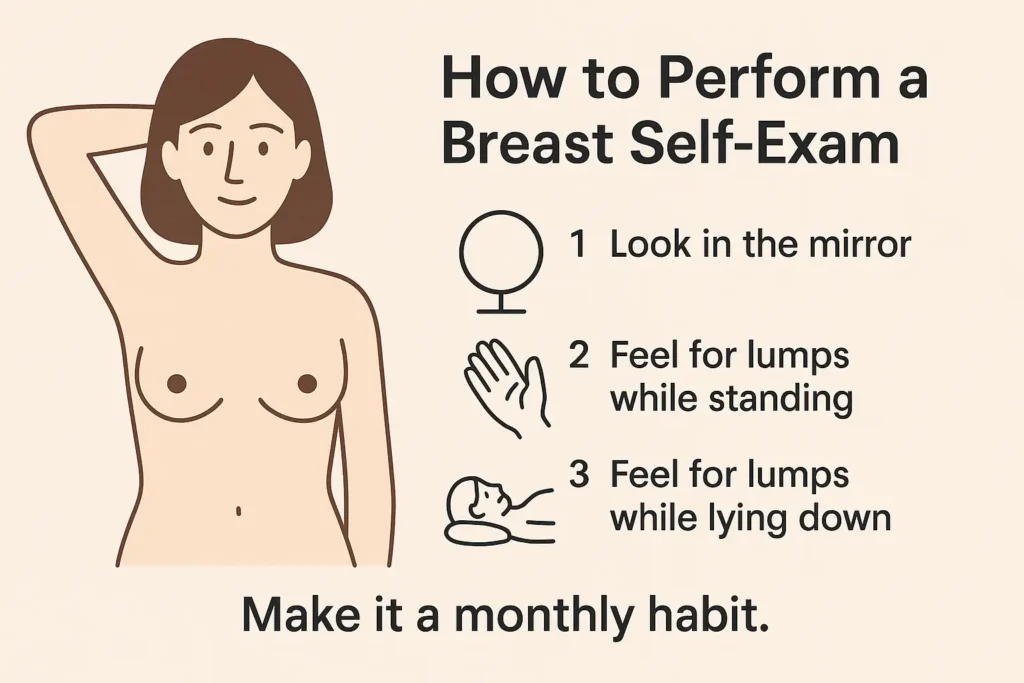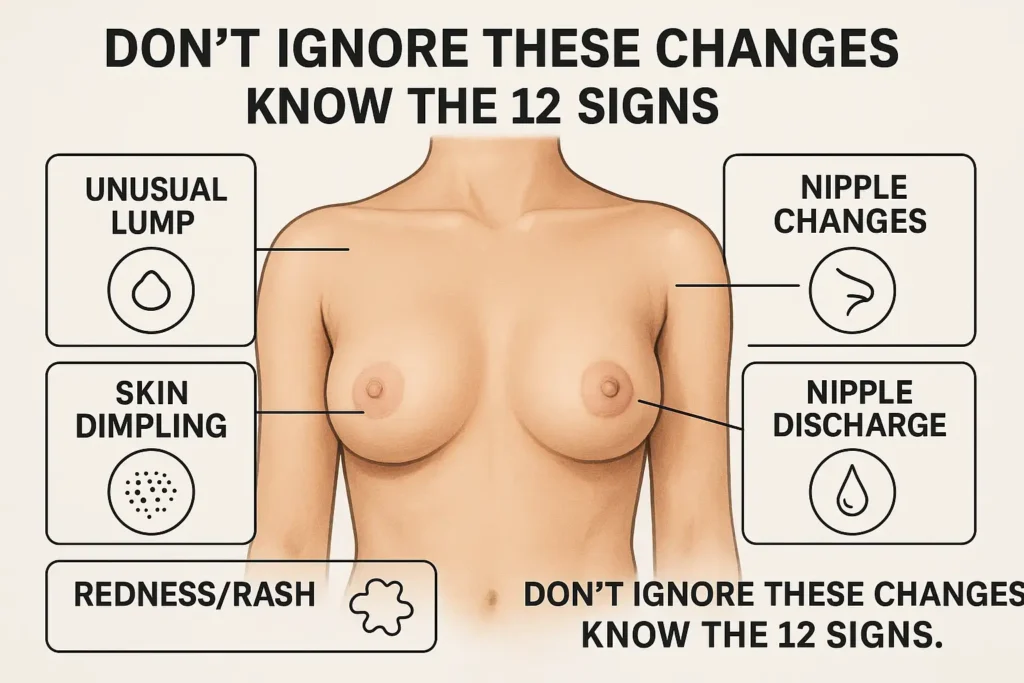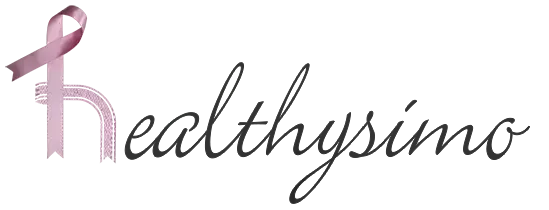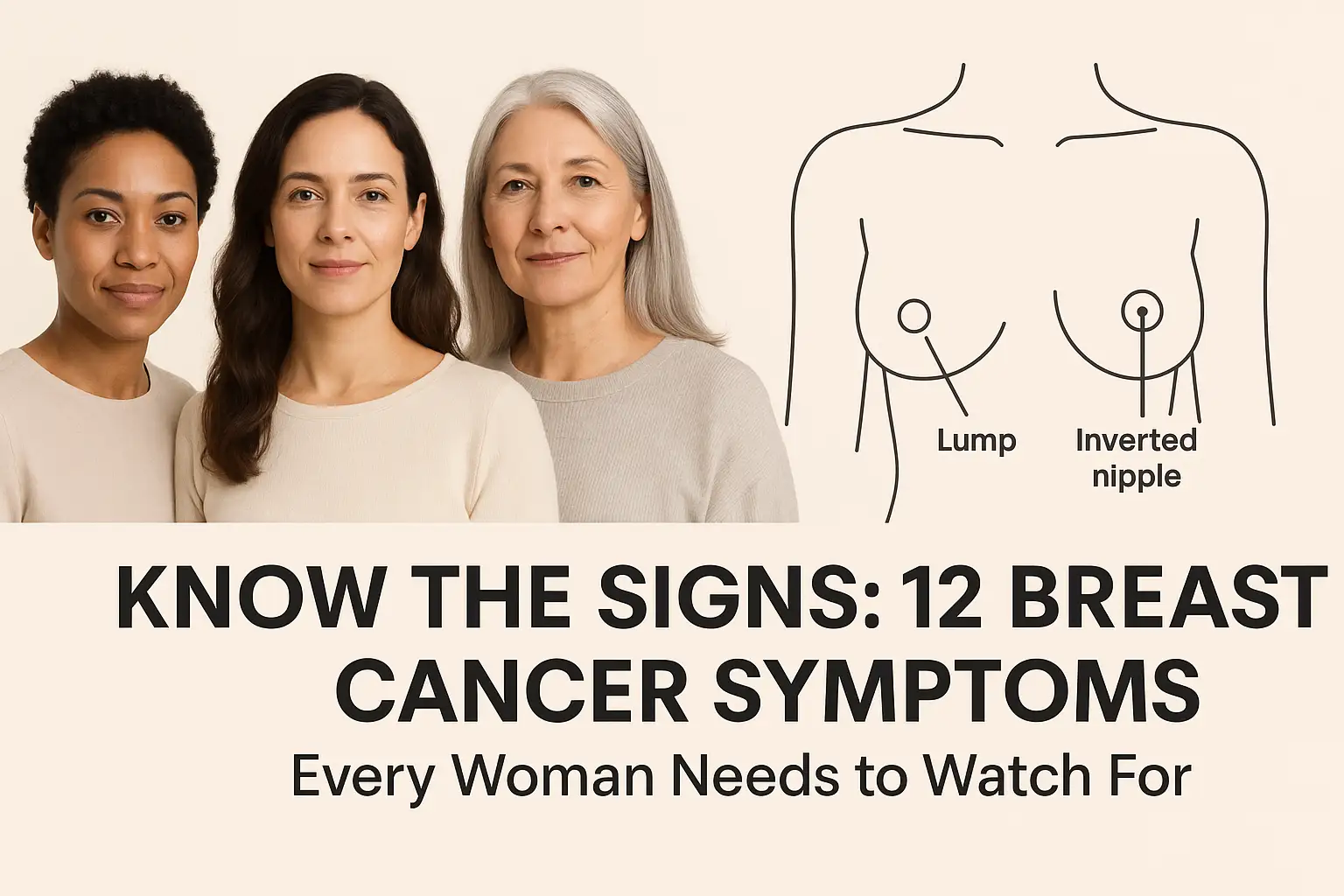Introduction to Breast Cancer Awareness and Early Detection
Breast cancer remains one of the most common cancers worldwide, significantly impacting women’s health. Its early detection is crucial because when identified early, treatment options and survival rates improve dramatically. This underscores the importance of awareness and understanding of breast cancer symptoms.
Recognizing the early signs of breast cancer can lead to prompt medical consultation and potentially lifesaving interventions. This post aims to empower readers with knowledge about the signs of breast cancer, highlighting how early detection can play a pivotal role in effective management and treatment. Awareness is the first step in proactive health management, and by educating ourselves and others, we contribute to the fight against this pervasive disease.
Let’s delve into the 12 symptoms that are key indicators of breast cancer, ensuring that every reader is equipped to notice and act on these warning signs.
By maintaining vigilance for these symptoms, individuals can take essential steps towards early detection, which is instrumental in navigating breast cancer more effectively.
Understanding Breast Cancer
Breast cancer is a disease where cells in the breast grow out of control. There are different kinds of breast cancer, which depend on which cells in the breast turn into cancer. The condition most commonly presents as a lump or mass in the breast tissue, although other physical changes can also indicate breast cancer.
Statistics and Importance of Early Detection:
Breast cancer is the most common cancer diagnosed among women, impacting millions worldwide. According to global health estimates, approximately 1 in 8 women will be diagnosed with breast cancer in their lifetime. These statistics underscore the critical importance of early detection, which can significantly improve the prognosis and treatment outcomes.
Early detection of breast cancer symptoms can lead to earlier diagnosis, which is often associated with a higher rate of successful treatment and survival. Regular screening tests, such as mammograms, are essential for catching the disease at an early stage before symptoms even appear. This proactive approach can drastically reduce the severity of the disease and increase the effectiveness of treatment options.
Educating oneself and others about breast cancer signs and the benefits of early detection can make a substantial difference in managing this disease effectively.

Sign 1: Changes in Breast Shape or Size
One of the early symptoms of breast cancer is a noticeable change in the size or shape of the breast. These changes can manifest in several ways:
- Asymmetry: One breast may appear noticeably larger or smaller compared to the other, beyond typical slight asymmetry that many women experience.
- Overall Enlargement or Shrinkage: There might be a general enlargement of the breast or parts of it, or a noticeable shrinkage without any apparent cause.
- Altered Contour: The contour or shape of the breast may change, showing visible distortion such as one area being more elevated or having a different profile than usual.
These changes can occur due to the growth of a tumor within the breast, which can affect the underlying tissues and skin. It’s important to note that while breasts often change due to factors like weight fluctuations, hormonal changes, or aging, sudden or noticeable alterations should prompt a consultation with a healthcare provider.
Being vigilant about these changes and consulting a healthcare professional if they occur can significantly aid in early detection of breast cancer. Regular self-examinations and professional evaluations are key components of recognizing the signs at an early stage.
Sign 2: Unusual Lumps or Thickening
Detecting unusual lumps or areas of thickening in the breast can be a critical early sign of breast cancer. Performing regular self-examinations can help you become familiar with the normal feel and appearance of your breasts, making it easier to notice any unusual changes.
How to Self-Examine:
- Visual Inspection: Stand in front of a mirror with your shoulders straight and your arms on your hips. Look for any changes in the contour, swelling, dimpling of the skin, or changes in the nipples. Then, raise your arms and look for the same changes.
- Physical Exam – Standing or Sitting:
- Use the pads of your fingers, keeping them flat and together. Use a firm, smooth touch with the first few finger pads of your hand, keeping the fingers flat and together. Use a circular motion, about the size of a quarter.
- Cover the entire breast from top to bottom, side to side — from your collarbone to the top of your abdomen, and from your armpit to your cleavage.
- Follow a pattern to ensure that you cover the whole breast. You can begin at the nipple, moving in larger and larger circles until you reach the outer edge of the breast.
- Physical Exam – Lying Down:
- When lying down, the breast tissue spreads out evenly along the chest wall. Place a pillow under your right shoulder and your right arm behind your head. Using your left hand, move the pads of your fingers around your right breast gently in small circular motions covering the entire breast area and armpit.
- Use light, medium, and firm pressure. Squeeze the nipple; check for discharge and lumps.
- Repeat these steps for your left breast.
What to Look For:
- Lumps or Knots: Feel for any lump, thickening, hardened knot, or any other breast changes.
- Consistency: Notice if the texture or consistency of your breast tissue changes from one area to another.
- Pain: Be aware of any areas that might be tender or painful to the touch which was not before.
Regular breast self-exams are a very useful and important way to detect early breast cancer. However, not all cancers can be found this way, which is why it’s important to have regular clinical breast exams and mammograms. If you notice any unusual changes, consult your healthcare provider immediately for a professional evaluation.
Sign 3: Skin Changes
Skin changes on the breast can be early indicators of breast cancer. These changes can manifest in several ways, each pointing to possible underlying issues that require further investigation:
- Dimpling: This symptom appears as indentations in the breast skin, often described as resembling an orange peel’s texture, known as “peau d’orange.” This textural change can indicate inflammation and could be due to the underlying breast cancer affecting the skin.
- Redness: Persistent redness over a portion of the breast skin that does not resolve with general skincare or changes in clothing can be concerning. It may feel warm or tender, and the skin might appear thickened.
- Other Skin Abnormalities: Look out for any unexplained changes such as new rashes or itchy areas, particularly if they are localized and persistent without apparent cause. These changes could also include hardened patches of skin or visible distortions that are not typical of normal skin changes.
It’s important to monitor any such alterations and consult with a healthcare provider for a thorough evaluation. Early detection of these signs can lead to early diagnosis and treatment, significantly improving outcomes.
Here is an illustration depicting various skin changes associated with breast cancer, designed to help you recognize these important signs.
Understanding these signs and acting upon them can significantly aid in catching breast cancer at an early, more treatable stage.
Sign 4: Changes in the Nipple
Changes in the appearance of the nipple can be significant indicators of breast cancer. These alterations might be subtle at first and are often overlooked, making it crucial to understand and recognize them promptly:
- Nipple Retraction (Inversion): This refers to the nipple turning inward or retracting into the breast instead of pointing outward. This change can occur gradually or suddenly and can be persistent or intermittent.
- Alterations in Appearance:
- Texture Changes: The skin on or around the nipple may become scaly, thickened, or appear pitted, similar to the skin of an orange.
- Color Changes: There may be a noticeable change in the color of the nipple area, which could turn darker or exhibit unusual redness.
These changes might be due to the underlying cancer pulling on the nipple or changes in the skin’s structure as the disease progresses. Such symptoms should prompt further examination and consultation with a healthcare professional.
Here’s an illustration showing various changes in the nipple that can be symptoms of breast cancer. This educational tool is designed to help you identify these changes.
It’s important to note any new or unusual changes in the nipple and consult with a healthcare provider for a thorough assessment. Early detection of these signs can lead to more effective treatment options and a better prognosis.
Sign 5: Nipple Discharge
Nipple discharge can vary widely in its consistency, color, and circumstances under which it appears, and it can be a symptom of breast cancer. Not all types of discharge are cause for concern, but understanding which characteristics may be indicative of cancer is crucial:
- Bloody Discharge: Any discharge that is bloody or pink-tinged can be a warning sign. While it can also be associated with benign conditions like papillomas, any presence of blood warrants immediate medical evaluation.
- Clear or Milky Discharge: Although often less concerning, clear or milky discharge that occurs without squeezing the nipple, particularly if it’s only from one breast, should be checked by a healthcare provider.
- Yellow, Green, or Purulent Discharge: These types of discharges are usually related to infections or non-cancerous conditions rather than cancer. However, they still require medical attention to determine the cause and appropriate treatment.
Here is an illustration that depicts various types of nipple discharge, categorized by their appearance and consistency. This visual guide can help you understand what might be normal and what should prompt a doctor’s visit.
It’s important to monitor any new or unexplained nipple discharge, particularly if it occurs without nipple manipulation. If you notice any unusual discharge, it’s advisable to consult with a healthcare provider for further evaluation to determine the cause and necessary treatment. Early detection and diagnosis can significantly affect the treatment options and outcomes.
Sign 6: Persistent Breast Pain
Breast pain is a common symptom experienced by many women at various points in their lives. However, distinguishing between normal breast pain and pain that could be indicative of breast cancer is important for timely and appropriate medical evaluation.
Normal Breast Pain:
- Cyclical Pain: Most commonly linked with menstrual cycles, this type of pain usually affects both breasts. It can also extend to the underarm area and vary in intensity throughout the cycle. Cyclical pain is typically most intense just before a menstrual period and often subsides during or after the period.
- Hormonal Changes: Hormonal fluctuations due to menstruation, pregnancy, or menopause can also cause generalized breast tenderness or swelling.
Concerning Breast Pain:
- Persistent Pain: Pain localized in one specific area of the breast that does not vary with the menstrual cycle and continues over a period of time can be concerning. This type of pain, especially if associated with other symptoms such as a lump or thickening, warrants further investigation by a healthcare provider.
- Non-cyclical Pain: This pain is less common and not related to the menstrual cycle. It could be continuous or intermittent but is usually concentrated in one area.
Here is an illustration that helps differentiate between normal and concerning breast pain. Understanding these differences is crucial and can aid in recognizing when to seek further medical advice.
If you experience persistent or localized breast pain that doesn’t seem to be associated with your menstrual cycle, it’s advisable to consult a healthcare provider. They can perform the necessary examinations and potentially schedule imaging tests to determine the cause of the pain. Early detection and diagnosis are key to managing any potential issues effectively.
Sign 7: Swelling in the Armpit or Collarbone Area
Swelling in the armpit or collarbone area can be an external manifestation of lymph node involvement, which may be related to breast cancer. The lymph nodes are small, bean-shaped structures that are part of the body’s immune system, and they help fight infections and diseases. When cancer spreads, it can reach the lymph nodes, particularly those closest to the breast, in the armpit (axillary lymph nodes) and near the collarbone.
How Lymph Node Involvement Can Manifest Externally:
- Swelling or Lump: You may notice swelling or feel a lump in the armpit or above the collarbone, even before detecting a lump in the breast. This could be due to cancer cells blocking lymphatic vessels, causing fluid to build up.
- Tenderness or Pain: The area might also be tender or painful to touch. However, pain is not always present with lymph node involvement.
- Firmness: The swollen nodes may feel firm or hard on palpation, and they might not move when pressed.
This kind of swelling is significant because it might suggest that the cancer has spread from where it started into nearby lymph nodes, which is a critical factor in determining the stage of breast cancer.
If you notice swelling or changes in the armpit or collarbone areas, it’s important to consult with a healthcare provider. They can perform a thorough examination and may recommend further diagnostic tests such as an ultrasound or a biopsy to assess the lymph nodes. Detecting cancer early, when it is most treatable, significantly increases the chances of successful treatment outcomes.
Sign 8: Scaliness or Thickening of the Nipple or Breast Skin
Scaliness or thickening of the skin on the nipple or breast can be indicative of several underlying issues, some of which may be related to breast cancer. These textural changes are significant and warrant further examination:
- Scaliness: This can appear as flaky or rough patches on the nipple or surrounding area, often resembling eczema. In some cases, it can be associated with Paget’s disease of the breast, a rare form of breast cancer that affects the nipple and the skin surrounding it.
- Thickening of Skin: This may feel like the skin of the breast is harder or denser than usual, particularly in one specific area. This thickening can sometimes be due to inflammatory breast cancer, a less common but aggressive form of the disease, which requires immediate medical attention.
Indications of Potential Underlying Issues:
- Persistent Changes: Any persistent change in the texture or appearance of the nipple or breast skin should be evaluated. This is especially true if these changes do not resolve with usual care, such as moisturizers or over-the-counter eczema treatments.
- Accompanying Symptoms: Look out for other symptoms such as redness, warmth, itching, or the presence of a lump or swelling. These can further suggest serious conditions including breast cancer.
If you observe scaliness or thickening of the skin on your breast or nipple, it’s crucial to consult a healthcare provider. They can assess whether these symptoms are benign or indicative of breast cancer through clinical examinations and potentially recommend further diagnostic tests like a mammogram or biopsy.
Early detection and diagnosis can significantly impact the effectiveness of treatment, improving the chances of a favorable outcome.
Sign 9: Breast Itchiness and Rashes
Breast itchiness and the appearance of rashes on the breast can sometimes be symptoms that are mistaken for common skin conditions like eczema. However, in certain cases, these symptoms can relate to more serious underlying health issues, including breast cancer.
How Eczema-Like Symptoms Can Relate to Breast Cancer:
- Paget’s Disease of the Breast: This is a rare form of breast cancer that starts in the ducts of the nipple and spreads to the skin of the nipple and then to the areola. It often causes symptoms that resemble eczema; the skin becomes red, itchy, and flaky. Unlike eczema, this condition is typically confined to one nipple and does not respond to typical dermatological treatments.
- Inflammatory Breast Cancer: Another serious condition associated with itchiness and a rash-like appearance is inflammatory breast cancer. This type of breast cancer can cause the skin to appear pink or reddish and feel warm. The skin might also show the texture of an orange peel, known as “peau d’orange.”

Key Points to Consider:
- Persistence of Symptoms: If you have persistent itchiness, redness, or rash on one breast that does not improve with topical treatments or changes in hygiene practices, it is important to consider a deeper medical evaluation.
- Other Associated Symptoms: Look for other symptoms such as thickening of the breast skin, changes in the nipple, or any swelling or pain in the area, which might further suggest the presence of breast cancer.
It’s crucial to consult with a healthcare provider if you notice any unusual changes to the breast skin. A proper diagnosis often requires a thorough examination, which may include imaging tests like a mammogram or an ultrasound, and sometimes a biopsy to determine the exact cause of the symptoms.
Sign 10: Changes in Breast Sensation
Changes in breast sensation, such as increased sensitivity or numbness, can be symptomatic of breast cancer, though they are often overlooked. These sensory changes can indicate various underlying issues, including nerve involvement or changes within the breast tissue itself.
Understanding Changes in Breast Sensation:
- Increased Sensitivity: Some individuals may experience heightened sensitivity in the breast, which can be localized to a specific area or more generalized. This symptom may be due to inflammation or growth within the breast that affects the surrounding nerves.
- Numbness: Numbness or a lack of sensation can occur if a tumor in the breast presses against nerves. This symptom is particularly concerning when it is localized and persistent, as it might suggest a larger or more invasive tumor.
Key Points to Consider:
- Pattern of Sensation Change: It is important to note whether the change in sensation is consistent or if it fluctuates over time.
- Accompanying Symptoms: These sensory changes are often accompanied by other signs, such as a lump, thickening of the breast tissue, or changes in the skin or nipple appearance.
Here is an illustration that highlights the areas where changes in breast sensation may occur, helping you to understand how sensitivity or numbness might present as symptoms of breast cancer.
If you notice any new or unusual changes in breast sensation, it is crucial to consult a healthcare provider for a thorough evaluation. Diagnosing the cause of these symptoms may require clinical exams, imaging studies, and possibly biopsies to ensure accurate diagnosis and appropriate management.
Sign 11: Asymmetry in Breast Appearance
Breast asymmetry involves a noticeable difference in size, shape, or position of one breast compared to the other. While it’s common for women to have slight differences between their breasts, significant changes that develop newly or progress over time can be a concern and might indicate an underlying condition such as breast cancer.
Understanding Asymmetry as a Symptom:
- Sudden Changes: If one breast suddenly appears larger, lower, or differently shaped than the other, especially if this change has developed recently, it could be a sign of growth within the breast, such as a tumor.
- Independence from Normal Cycles: These changes should be considered especially significant if they do not fluctuate with menstrual cycles or other hormonal changes that normally might cause temporary asymmetry.
What to Look For:
- Visible Distortion: One breast may look distinctly different; for example, one side may hang differently or have a noticeable variation in contour.
- Feel of Tissue: The affected breast might feel different in terms of the internal texture when compared to its counterpart. A lump or thickening that is palpable in one breast and not in the other could be the cause of the asymmetry.
If you notice any new asymmetry in your breasts, it is important to consult with a healthcare provider. They will likely perform a clinical breast exam and may recommend further imaging, such as a mammogram or ultrasound, to investigate the cause of the asymmetry.
Sign 12: Inward Pulling of the Nipple
Inward pulling of the nipple, also known as nipple retraction or inversion, is a potential sign of breast cancer that can occur due to underlying changes within the breast tissue. This symptom can be either new or progressive and is important to evaluate in the context of other breast changes.
Understanding Nipple Inversion:
- Causes: Nipple inversion can occur when there is fibrosis, shortening of the ducts, or when a tumor growing within the breast pulls the nipple towards it. These changes might disrupt the normal architecture and elasticity of the breast, causing the nipple to retract.
- Differential from Normal: While some people may have naturally inverted nipples, the concern arises when there is a change from the nipple’s usual position, especially if this change is unilateral (occurs in one breast only) and recent.
What to Look For:
- Sudden Changes: A nipple that was previously protruding but begins to pull inward should be examined by a healthcare provider.
- Associated Symptoms: Pay attention to other symptoms such as discharge, localized pain, or the presence of a lump in the breast, as these can accompany the retraction and provide further clues to the underlying cause.
Here is an illustration that shows the inward pulling of the nipple, helping you to visualize how and why this occurs as a symptom of breast cancer.
If you notice this change, it’s crucial to seek a professional evaluation. A healthcare provider will likely perform a clinical exam and may recommend imaging tests such as mammography or ultrasound to explore the underlying cause of the nipple inversion.
Prompt recognition and diagnosis of such changes are key to effective treatment, particularly if the cause is breast cancer. Early detection can lead to more successful management and potentially less invasive treatment options.

Action Steps and Early Detection Strategies
Early detection of breast cancer greatly increases the chances of successful treatment. Here are some crucial action steps and strategies for early detection:
Regular Screenings:
- Clinical Breast Exams (CBE): Women should have regular clinical breast exams by a healthcare professional. These exams can help detect abnormalities that might not be noticeable to the individual.
- Age-Specific Guidelines: Women over 40 are generally recommended to have a mammogram every 1-2 years, but guidelines can vary based on individual risk factors. Discuss with your healthcare provider to determine the best schedule for you.
Self-Examinations:
- Monthly Checks: Starting in their 20s, women should be encouraged to perform monthly breast self-exams. Knowing your own breasts and being aware of changes can help detect early signs of potential issues.
- Technique: Use a systematic method to check the entire breast area, including the armpits, for any lumps, thickening, or changes in skin texture.
Mammograms:
- Early Detection Tool: Mammography can detect tumors before they can be felt and can also find microcalcifications (tiny deposits of calcium) that sometimes indicate the presence of breast cancer.
- Digital Mammograms: More detailed and clearer than traditional mammograms, especially for women under 50 or those with dense breasts.
Medical Consultations:
- Discuss Risk Factors: It’s important to talk about your personal and family medical history with a doctor, as some factors might increase your risk.
- Regular Updates: Keep your healthcare provider informed about any new changes or symptoms you experience.
Here is an infographic that outlines these important steps and strategies, making it easier to understand how regular screenings, self-examinations, mammograms, and consultations play a role in the early detection of breast cancer.
Adopting these practices into your routine can significantly aid in catching breast cancer early when it is most treatable. Stay proactive about your breast health and consult your healthcare provider for personalized advice based on your specific risk factors and health history.
Conclusion
Awareness and early detection of breast cancer can significantly impact outcomes. Throughout this post, we’ve explored crucial signs of breast cancer, including changes in breast shape or size, unusual lumps, skin alterations, nipple changes, and other symptoms such as discharge, pain, or swelling. Understanding these signs is vital for early diagnosis and effective treatment.
Recap of the Signs:
- Physical changes: Look for new lumps, changes in breast size or shape, and alterations in the skin or nipple.
- Sensory changes: Be aware of any new pain, sensitivity, or numbness.
- Visible changes: Notice any inward pulling of the nipple, persistent skin redness, or thickening.
We encourage everyone to be proactive about their breast health. Regular self-examinations and medical screenings like mammograms play a crucial role in detecting breast cancer early. If you notice any of the symptoms discussed, or if something feels ‘off,’ please consult with a healthcare provider without delay. They can offer guidance, support, and necessary medical evaluations.
By staying informed and vigilant, we can all contribute to the fight against breast cancer. Remember, your health is important, and taking timely action can make a significant difference. Let’s continue to support each other and prioritize our health with regular check-ups and awareness.
Ressources
For those seeking more information on breast cancer, including its signs, treatment options, and support networks, numerous reputable sources can provide valuable insights and assistance. Here are several recommended resources for further reading and support:
- American Cancer Society (ACS)
- Website: cancer.org
- Provides comprehensive information on breast cancer, including detection, diagnosis, treatment options, and patient support.
- National Breast Cancer Foundation (NBCF)
- Website: nationalbreastcancer.org
- Offers free breast cancer guides, information on breast health, and programs that provide support and early detection services.
- Breastcancer.org
- Website: breastcancer.org
- A nonprofit organization offering detailed information about breast cancer stages, symptoms, types, and treatment options.
- Susan G. Komen Foundation
- Website: komen.org
- Known for funding research and supporting those affected by breast cancer, with extensive resources for patients and advocates.
- World Health Organization (WHO)
- Website: who.int
- Provides global perspectives on breast cancer incidence, prevention strategies, and policies for reducing the disease burden.


0 thoughts on “Know the Signs: 12 Breast Cancer Symptoms Every Woman Needs to Watch For”